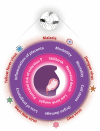Mothers and mosquitoes: climate change contributes to the spread of vector-borne pathogens posing a substantial threat to pregnant women
- PMID: 40272573
- PMCID: PMC12021716
- DOI: 10.1007/s00281-025-01050-z
Mothers and mosquitoes: climate change contributes to the spread of vector-borne pathogens posing a substantial threat to pregnant women
Abstract
Infectious diseases have threatened individuals and societies since the dawn of humanity. Certain population groups, including pregnant women, young children and the elderly, are particularly vulnerable to severe infections. Over the past few centuries, advances in medical standards and the availability of vaccines have reduced infection-related mortality and morbidity rates in industrialized countries. However, the global rise in temperatures and increased precipitation present a new challenge, facilitating the broader distribution of disease vectors, such as mosquitoes, bugs and ticks, to higher altitudes and latitudes. Consequently, epidemic and pandemic outbreaks associated with these vectors, such as Zika, West Nile, dengue, yellow fever, chikungunya and malaria, are increasingly impacting diverse populations. This review comprehensively examines how infections associated with climate change disproportionately affect the health and well-being of pregnant women and their unborn children. There has been a noticeable emergence of vector-borne diseases in Europe. Consequently, we stress the importance of implementing measures that effectively protect pregnant women from these increasing infections globally and regionally. We advocate for initiatives to safeguard pregnant women from these emerging threats, beginning with enhanced education to raise awareness about the evolving risks this particularly vulnerable population faces.
Keywords: Climate change; Fetal infection; Guidelines; Maternal immune activation; Maternal infection; Vector-borne diseases; Vertical transmission.
© 2025. The Author(s).
Conflict of interest statement
Declarations. Competing interests: PA is the Editor-in-Chief of this Journal. Thus, an independent Editor was responsible for supervising the peer review process. This manuscript has not been given priority and has undergone the same peer-review process as other manuscripts in this Journal. The other authors have no competing interests to declare that are relevant to the content of this article.
Figures


References
-
- Aleem A, Akbar Samad AB, Vaqar S (2024) Emerging variants of SARS-CoV-2 and novel therapeutics against coronavirus (COVID-19). In StatPearls. Treasure Island (FL): StatPearls publishing copyright © 2024. StatPearls Publishing LLC - PubMed
-
- Intergovernmental Panel on Climate Change (IPCC) (2023) Climate change 2022 – Impacts, adaptation and vulnerability: working group II contribution to the sixth assessment report of the intergovernmental panel on climate change. Cambridge University Press, Cambridge
-
- de Souza WM, Weaver SC (2024) Effects of climate change and human activities on vector-borne diseases. Nat Rev Microbiol 22:476–491 - PubMed
Publication types
MeSH terms
LinkOut - more resources
Full Text Sources
Medical
Miscellaneous

